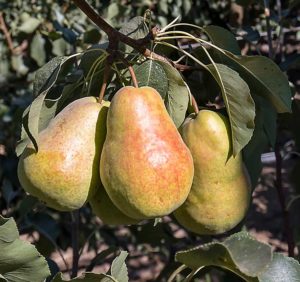—story and photos by Kate Prengaman
—photo by TJ Mullilnax

There’s something you don’t see every day growing on the slopes along the Entiat River Valley in North Central Washington: acre after acre of baby pear trees.
So many, in fact, that the tree orders — spread among several nurseries — nearly cleaned out the industry’s supply of pear rootstock. All to produce enough HW 624 trees to supply Stemilt Growers’ new Happi Pear program.
The investment is a big bet on the future of pears, according to Mike Taylor, who both owns those new orchards in Entiat and serves as vice president of business development at Stemilt Growers.
In other words: He’s all in.

“We need a renewal. It’s do or die,” Taylor said of Washington’s pear industry. “We’ve got old, outmoded orchards, and it hasn’t been easy to know what to do.”
The rollout of the Happi Pear — offering more horticultural efficiencies for growers and something new for consumers to be excited about — marks a first step, Taylor said. Moreover, he believes it’s a playbook for more innovation to come.
“With improved flavor, great marketing and consumer satisfaction we can grow category sales,” he said. He shared the same message this winter when the pear industry honored him with the Silver Pear Award.
Of course, as a managed variety, Happi Pears aren’t a solution for everyone. Stemilt limited the first phase of planting (most of which are planted by its outside growers, including Taylor) for now, but if it gains market traction, as Taylor expects, it will be licensed to other warehouses in the future.
Mount Adams Fruit already planted some in its orchards along the Columbia River near Oregon, said CEO Doug Gibson.
“We’re super-excited about it. It’s a summer pear with more of that off-the-shelf eating experience,” he said. Their young orchards are just coming into production, so Stemilt will pack and market the fruit this year, but as the volume grows, Mount Adams plans to pack and sell as well.
Partnering with a company in a different region will help the new program hedge against freeze damage or other crop loss, Gibson added.
Gibson agrees with Taylor that pears offer some new excitement: Along with a new variety, the industry’s investment in better ripening practices has improved Anjou quality.
The new pear
Touring a fourth-leaf HW 624 block near Entiat, Rob Blakey, Stemilt’s director of research and development, is pleased with the crop load, especially given the cold damage experienced around the region. The variety’s earlier cropping is critical to getting a cash flow back to growers, he said.
He ticks off the HW 624’s positives: The summer pear has a wider harvest window, a unique flavor that can be enjoyed crunchy off the tree or as a melting type, and it’s tolerant of fire blight and pear psylla. Those attributes should make it more efficient to grow and handle than the traditional varieties, much like the efficiencies that attracted the apple industry to WA 38, he said.

Growers have planted it in tall-spindle-type systems, at 5- by 14-foot or 4- by 12-foot spacing, he said, or they’ve opted to go tighter with multiple leaders to try to spread out the vigor. Like a high-density apple, more intense systems have less margin for error in terms of training, he said.
The transition from traditional orchards to high-density, single-variety blocks also required research into pollinizers and pollen application, both ongoing, Blakey said.
Blaine Smith, a Cashmere-area grower with an HW 624 planting in its second leaf, said he was attracted to how the variety “grows more like an apple tree” and easily grows lots of lateral branches.
“We think we can get fruit closer to the leader and have more small fruiting wood,” he said of his high-density system, trained with three leaders and maintained with click pruning. “The challenge is these new blocks cost $60,000 an acre to do that. That’s really hard for small growers.”
The new playbook
Given the capital costs of replanting, pear growers need a program, not just a new variety, Blakey said. That means developing a knowledge base on how to grow, market and handle a new variety, too. Stemilt’s new pear packing line, set to run this fall, will help.
HW 624 is the first launch under this approach, but Blakey has 22 other pears under evaluation, hoping to find a few more that can fill different needs for growers and consumers.

Efficiencies alone won’t cut it. The pear also must prove it can return well above the cost of investing in new plantings, Taylor said. That requires top-notch handling and smart marketing.
“The orchard economics have to be really successful to justify the planting,” he said. “We’re in it together. It’s a three-legged stool between the grower, who is willing to take the risk, the packer/marketer, and the consumer, who should be willing to pay for it if it can walk the talk.”
Will consumers pay more for premium pears? Evidence from the apple category suggests as much, Taylor said, but he also wants to see pears differentiate themselves from the apple model while moving forward.
Expecting year-round availability? No, he’d rather see the year divided into seasons to allow traditional and new varieties to play to their strengths and optimum quality windows.
Pricing on par with commodity apples to move volume? No, he believes better pears can demand better prices. (And by better, he means better eating quality of traditional cultivars with proper handling, too).
“We have to make the product exciting enough it can sell for $2 to $3 per pound,” he said. “We don’t have the efficiencies of apples, and we aren’t going to get them. We need to price pears to allow the category to move forward, or we’ll die a slow death.” •







Leave A Comment